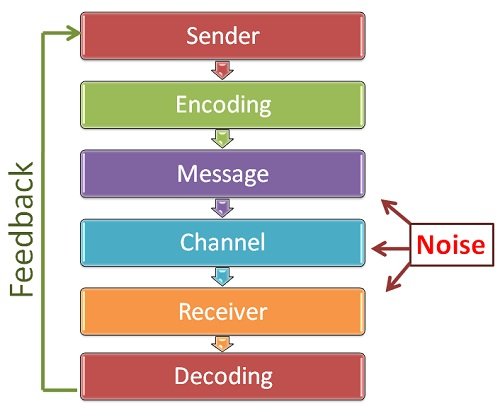In the course of the day to day living, human beings need to participate with other human beings and the world around them. Communication is the process of sharing thoughts, ideas, and emotions with others and having those thoughts, ideas, and emotions understood.
Communication is essentially the process of exchanging one’s views or feelings with another person. It is the process of sending and receiving messages and the process of meaningful interaction among human beings. It involves a sequence of events in which a sender sends a verbal or non–verbal message to a recipient.
Communication is a cyclic process that involves initiation, transmission, and reception of information. Communication is considered effective when it achieves the desired reaction or response from the receiver. The process of communication consists of many elements. These components are interrelated to constitute the process of communication.
The main essential elements\ components of the communication process are the following:-
-
Context:-
Every communication proceeds with a context. This context may be physical, social, cultural, or any other. The sender chooses the message to communicate within a context. Every message whether oral or written begins with an idea that arises in some context.
It is the context that prompts one to communicate an idea. The source of this promptness may be a letter, memo, fax, telephone call, e-mail etc.

-
The Sender:-
The sender is where communication begins. A sender is the encoder of the message.
The sender wants to communicate with another person or organization to achieve some objective. He makes use of verbal or non-verbal symbols to convey the message.
-
Message:-
The sender has the intention to communicate with another person. The intention or idea makes up the message. A message is an encoded idea transmitted by the sender.
The idea is converted or encoded into a message by using words, signs, gestures, symbols or body movements etc.
The message can be expressed in different ways depending upon the subject, purpose, audience, personal style or culture background of the sender.
-
Medium and channel:-
The method and means used to exchange or transmit the message are called medium and channel respectively. For the message to be effective and correctly interpreted by the receiver, appropriate medium, depending on the purpose of the receiver.
For example, an oral medium can be chosen when spontaneous feedback is desired from the recipient or some misunderstandings are to be cleared then and there. If an oral message is conveyed using a telephone then oral is the medium and telephone is the channel.
-
Recipient\Receiver:-
A receiver is a destination of the message. He may be a listener or a reader or a viewer of the message. The receiver not only receives the message but also understands what is implied in the message.
If the receiver does not have the ability to listen, to read, to think, he will not be able to receive and decode the messages in the manner the communicator wants him to. For effective communication, the receiver is the most important link in the communication process.
The receiver is the decoder who decodes or understands the message and then gives necessary feedback. If the receiver understands the meanings of the words or the symbols correctly then his decoding is perfect.
-
Feedback:-
It is the response or acknowledgment of the receiver to the communicator’s message. It is the final link in the communication process.
Feedback is the main component of the communication process as it permits the sender to analyze the efficacy of the message. It tells the sender how the receiver has interpreted the message. The exchange is possible only if the receiver responds.
In face-to-face communication, the receiver responds naturally, directly and immediately. This provides the communicator an opportunity to improve and make his communication effective. In this way, both participants in communication interact and constantly exchange roles.
Feedback, thus, provides an opportunity to evaluate what is right or wrong about a particular communication. Feedback may be verbal or non-verbal (in the form of smiles, sighs, etc.). It could also be in written form (memos, reports etc). It helps to regulate the conversation between two or more individuals.
An effective communicator is always sensitive to feedback.
Objectives of process Communication:-
Following are the objectives of process communication:-
- To understand the process of communication.
- To understand the role of communicator.
- To study the process of encoding the message.
- To study the channels and feedback communication process.